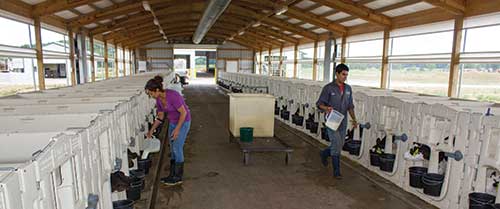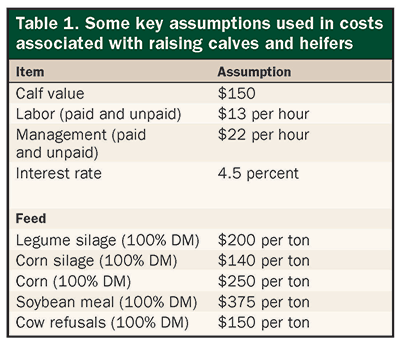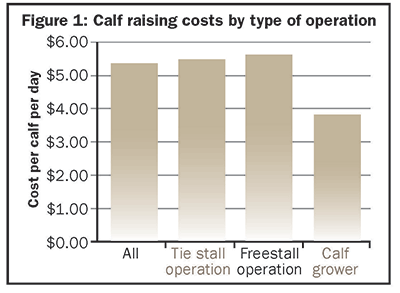The author is the Eau Claire County UW-Extension agricultural agent.

The next generation of your herd brings great potential, but it comes at a price. Calf and heifer rearing costs are one of the largest expenditures on a dairy. Unfortunately, many farms don't have a firm grasp of what they spend raising replacements.
To determine current benchmarks for calf and heifer rearing costs, 12 UW-Extension agriculture agents collected data from 34 dairy farms and custom calf and heifer growers across Wisconsin in the spring of 2013. Previous field studies of this nature had been conducted by UW-Extension in 1999 and 2007.
The data from all three studies were entered into an ICPA (Intuitive Cost of Production Analysis) model developed by then UW-Extension dairy scientist Pat Hoffman in 1997. The model estimates replacement rearing costs, labor efficiencies and has been modified to include the evaluation of a broad array of calf and heifer rearing systems. The ICPA model conducts an independent analysis of calf and heifer rearing enterprises and also provides an efficient mechanism to uncouple herd replacement enterprise costs from lactating cow costs.
Using the collected data, UW-Extension was then able to determine average calf and heifer raising costs. A few cost assumptions were made to standardize certain inputs, and those assumptions are listed in Table 1. All other numbers used in the study were producer specific and represent real farm costs.

Where calf costs lie
The farms were divided into three groups:
For this study, a calf was defined as an animal from birth until she was moved into group housing. Calf rearing expenditures were broken into four categories: feed, labor and management, variable costs (veterinary service, bedding, death loss and interest) and fixed costs (housing and equipment).
Information collected showed that the cost to raise a calf from birth until the time she was moved to group housing was $363, or $5.34 per day. Average weaning age was 68.6 days, or 7.61 weeks. The operation with the lowest costs could raise a calf for $168.21, while the one with the highest costs spent $904.03.
On the tie stall dairies, calf costs were $5.48 per day, slightly less than freestall dairies at $5.59 (see Figure 1). When taking a closer look, we see that feed costs and variable costs on the freestall dairies were lower, but the tie stall dairies showed more efficiency in labor management in addition to lower fixed costs.

Feed is biggest expense
Feed proved to be the most expensive input, accounting for almost 45 percent of calf raising costs on average. These farms spent approximately $165 per calf, or $2.40 per day, on feed. Costs included liquid feed (milk replacer or pasteurized milk), starter and forages. Feed prices varied greatly and ranged from $44 to $513 per calf, or $0.64 to $7.47 per day.
Labor and management costs were the next largest expense at $134 per calf, or $1.95 per day. Type of operation clearly impacted labor costs. Tie stall and freestall herds spent $154.58 and $141.36 per calf, respectively, while custom growers spent just $62.98.
Operations spent an average of 9.95 hours per calf from birth to weaning on labor and management tasks. Freestall and tie stall operations spent 10.58 and 11.23 hours, respectively, per calf. Custom growers trimmed that number by more than half, to 4.62 hours per calf, reducing labor and management costs substantially.
Variable costs, excluding labor and management, were about $41 per calf (64 cents per day). Variable costs were similar between all three types of operations. Fixed costs averaged $23 per calf, or 35 cents per day. Freestall operations had fixed costs of $31.86 per calf; tie stall and custom grower operations spent half of that.
Custom growers were best able to take advantage of economies of scale. Their average cost to raise a calf was $3.81 per day. This was a result of lower feed costs along with lower variable and fixed costs.
How things have changed
Study results show that calf and heifer enterprise costs have changed from 2007 to 2013. For starters, to match current market prices the assigned calf value was lowered from $500 in 2007 to $150 in 2013.
Between 2007 and 2013, feed costs rose more than $50 to $165 per calf. The higher price for milk replacer, however, was offset by more producers feeding pasteurized waste milk. As a result, across all herds, the cost of liquid feed for dairy calves only grew 9.3 percent in those six years. Unlike liquid milk, calf starter price tripled during the same time frame.
Both variable costs and expenses for labor and management went down from 2007. Fixed costs were stagnant between the 1999 and 2007 studies; however, in 2013 they almost doubled to $23 per calf. This difference reflects an investment in constructing new calf buildings or renovating older facilities.
As was the case in 1999 and 2007, custom growers were able to raise calves at the lowest cost in 2013. Costs between tie stall and freestall operations were not significantly different.
Consider your numbers
Calf raising is an expensive part of a dairy operation, but it is often overlooked since no direct income is derived from the replacement herd. The data shared in this and future articles provide an excellent benchmark for producers and agribusiness professionals.
This information could be used to compare the performance and cost of your own replacement program and identify areas to improve efficiency and profitability. To truly understand your own costs of production, you should always look at your actual farm inputs.
This is the first in the series. Click to read the other articles.
Second issue: Feed consumes heifer costs
Third issue: Comparing 1999, 2007 and 2013
Click here to return to the Calf & Heifer E-Sources
140310_156

The next generation of your herd brings great potential, but it comes at a price. Calf and heifer rearing costs are one of the largest expenditures on a dairy. Unfortunately, many farms don't have a firm grasp of what they spend raising replacements.
To determine current benchmarks for calf and heifer rearing costs, 12 UW-Extension agriculture agents collected data from 34 dairy farms and custom calf and heifer growers across Wisconsin in the spring of 2013. Previous field studies of this nature had been conducted by UW-Extension in 1999 and 2007.
The data from all three studies were entered into an ICPA (Intuitive Cost of Production Analysis) model developed by then UW-Extension dairy scientist Pat Hoffman in 1997. The model estimates replacement rearing costs, labor efficiencies and has been modified to include the evaluation of a broad array of calf and heifer rearing systems. The ICPA model conducts an independent analysis of calf and heifer rearing enterprises and also provides an efficient mechanism to uncouple herd replacement enterprise costs from lactating cow costs.
Using the collected data, UW-Extension was then able to determine average calf and heifer raising costs. A few cost assumptions were made to standardize certain inputs, and those assumptions are listed in Table 1. All other numbers used in the study were producer specific and represent real farm costs.

Where calf costs lie
The farms were divided into three groups:
- herds that milk in a tie stall barn (tie stall)
- herds that milk in a parlor (freestall)
- calf and/or heifer growers (custom growers)
For this study, a calf was defined as an animal from birth until she was moved into group housing. Calf rearing expenditures were broken into four categories: feed, labor and management, variable costs (veterinary service, bedding, death loss and interest) and fixed costs (housing and equipment).
Information collected showed that the cost to raise a calf from birth until the time she was moved to group housing was $363, or $5.34 per day. Average weaning age was 68.6 days, or 7.61 weeks. The operation with the lowest costs could raise a calf for $168.21, while the one with the highest costs spent $904.03.
On the tie stall dairies, calf costs were $5.48 per day, slightly less than freestall dairies at $5.59 (see Figure 1). When taking a closer look, we see that feed costs and variable costs on the freestall dairies were lower, but the tie stall dairies showed more efficiency in labor management in addition to lower fixed costs.

Feed is biggest expense
Feed proved to be the most expensive input, accounting for almost 45 percent of calf raising costs on average. These farms spent approximately $165 per calf, or $2.40 per day, on feed. Costs included liquid feed (milk replacer or pasteurized milk), starter and forages. Feed prices varied greatly and ranged from $44 to $513 per calf, or $0.64 to $7.47 per day.
Labor and management costs were the next largest expense at $134 per calf, or $1.95 per day. Type of operation clearly impacted labor costs. Tie stall and freestall herds spent $154.58 and $141.36 per calf, respectively, while custom growers spent just $62.98.
Operations spent an average of 9.95 hours per calf from birth to weaning on labor and management tasks. Freestall and tie stall operations spent 10.58 and 11.23 hours, respectively, per calf. Custom growers trimmed that number by more than half, to 4.62 hours per calf, reducing labor and management costs substantially.
Variable costs, excluding labor and management, were about $41 per calf (64 cents per day). Variable costs were similar between all three types of operations. Fixed costs averaged $23 per calf, or 35 cents per day. Freestall operations had fixed costs of $31.86 per calf; tie stall and custom grower operations spent half of that.
Custom growers were best able to take advantage of economies of scale. Their average cost to raise a calf was $3.81 per day. This was a result of lower feed costs along with lower variable and fixed costs.
How things have changed
Study results show that calf and heifer enterprise costs have changed from 2007 to 2013. For starters, to match current market prices the assigned calf value was lowered from $500 in 2007 to $150 in 2013.
Between 2007 and 2013, feed costs rose more than $50 to $165 per calf. The higher price for milk replacer, however, was offset by more producers feeding pasteurized waste milk. As a result, across all herds, the cost of liquid feed for dairy calves only grew 9.3 percent in those six years. Unlike liquid milk, calf starter price tripled during the same time frame.
Both variable costs and expenses for labor and management went down from 2007. Fixed costs were stagnant between the 1999 and 2007 studies; however, in 2013 they almost doubled to $23 per calf. This difference reflects an investment in constructing new calf buildings or renovating older facilities.
As was the case in 1999 and 2007, custom growers were able to raise calves at the lowest cost in 2013. Costs between tie stall and freestall operations were not significantly different.
Consider your numbers
Calf raising is an expensive part of a dairy operation, but it is often overlooked since no direct income is derived from the replacement herd. The data shared in this and future articles provide an excellent benchmark for producers and agribusiness professionals.
This information could be used to compare the performance and cost of your own replacement program and identify areas to improve efficiency and profitability. To truly understand your own costs of production, you should always look at your actual farm inputs.
This is the first in the series. Click to read the other articles.
Second issue: Feed consumes heifer costs
Third issue: Comparing 1999, 2007 and 2013
140310_156








